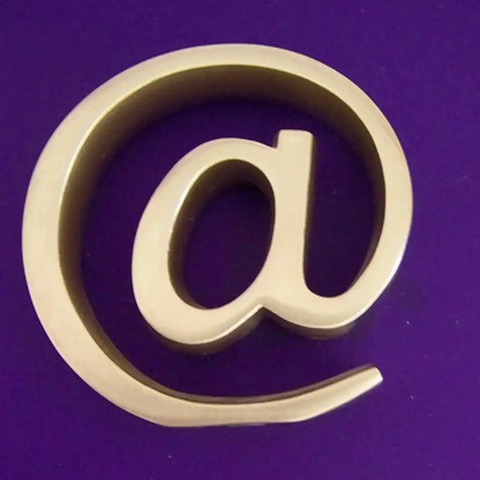The some 300 BILLION e-mails sent daily worldwide, would not be possible
without the symbol @.

By Jill Lowe

Indispensable, vital as one of the necessities for life: food, shelter, freedom from want and being safe from attack? No no.
The word indispensable in this case is for when those basic needs have been met ie living in our world as usual residents of our cities and rural areas across the developed world.

Widely credited with inventing the modern email, it was in 1971 that Ray Tomlinson, Engineer at MIT was commissioned by the US government to design the web. In developing a message system, he was looking for a symbol to separate the name of the message recipient from the name of their computer and to him, the @ sign made the most sense. At the time the symbol @ was probably the least used key on the keyboard and is now ubiquitous.
I first heard Fennela Kernabone from ABC Australia interviewing Paola Antonelli in 2012. This was 2 years after Antonelli, Senior Curator of Architecture and Design at the Museum of Modern Art, as well as MoMA’s founding Director of Research & Development. had anointed the @ symbol into MOMA’s permanent collection.
Speaking then, Paola Antonelli described the history of the symbol. In medieval times, monks used it as the Latin preposition ad – “in relation to,” and merchants in Venice and Geneva commenced its use to connect price and quantity- as in 44 bottles @ £5.
Known as the commercial a, it was used almost exclusively by accountants to mean “at the rate of.”
It has been seen on typewriters since the nineteenth century.
Does the symbol @ have a name?
The sign is now part of everyday life all over the world, demonstrated by the affectionate names it has in different cultures.
Germans, Poles, and South Africans call @ “monkey’s tail or apetail,“
Chinese see a little mouse.
Italians and French a snail. Apparently, the word ‘arobase’ is also used in France.
The Finnish know it as the ‘miukumauku’, the “sign of the meow,” because it resembles a
curled-up sleeping cat.
In Dutch, it is called ‘apestaart’, which means “monkey’s tail”.
In Japan it’s called the ‘atomaaku’.
In Greek it’s called ‘papaki‘ which means little duck.
In Korea, it is called ‘golbangi‘ for the resemblance to a snail.
Usage of e-mail
Oh yes, it is 52 years since the first e-mail but developments over the years made it more and more friendly for the average consumer to adopt. With webmail, It was closer to 1996 to be able to access email from any computer with an internet connection.
My elderly father was an early adopter of technology, already using closed-circuit TV technology as a low vision aid for his macular degeneration. Allowing 82x magnification he could see some TV and read wine labels and such. In 2000 he recruited assistance from my brother to establish an email address. Oh yes, an early adopter and one who had a way with words but with an aversion to what he felt were SILLY words.
His stipulation to my brother was that he supposed he would need to accept an address to include a “silly” name as Yahoo or the like but he absolutely, categorically insisted that any e-mail address for him not have that silly @ included! “Well Dad, I guess that means you will not get an e-mail address!” He of course acquiesced!
Notes, References
Image of Jill: Joe Mazza Bravelux inc.
Photos not attributed- copyright © 2022 Jill Lowe. All rights reserved
Paola Antonelli MOMA
the History of the @ symbol
The Accidental History of the @ symbol







